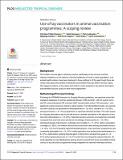| dc.description.abstract | Background
The human resource gap in veterinary sectors, particularly in low-income countries, imposes limitations on the delivery of animal healthcare in hard-to-reach populations. Lay animal health workers have been deployed in these settings to fill the gap though there are mixed views about the benefits of doing this and whether they can deliver services safely. We mapped evidence on the nature and extent of roles assigned to lay animal vaccinators, and identified lessons useful for their future deployment.
Methodology/Principal findings
Following the PRISMA Extension for Scoping Reviews guidelines, we searched seven bibliographic databases for articles published between 1980 and 2021, with the search terms lay OR community-based OR volunteer AND "animal health worker" OR vaccinator*, and applied an a priori exclusion criteria to select studies. From 30 identified studies, lay vaccinators were used by non-government developmental (n = 12, 40%), research (n = 10, 33%) and government (n = 5, 17%) programmes to vaccinate domestic animals. The main reason for using lay vaccinators was to provide access to animal vaccination in the absence of professional veterinarians (n = 12, 40%). Reported positive outcomes of programmes included increased flock and herd sizes and farmer knowledge of best practice (n = 13, 43%); decreased disease transmission, outbreaks and mortality (n = 11, 37%); higher vaccination coverage (10, 33%); non-inferior seroconversion and birth rates among vaccinated herds (n = 3, 10%). The most frequently reported facilitating factor of lay vaccinator programmes was community participation (n = 14, 47%), whilst opposition from professional veterinarians (n = 8, 27%), stakeholders seeking financial gains to detriment of programmes goals (n = 8, 27%) and programming issues (n = 8, 27%) were the most frequently reported barriers. No study reported on cost-effectiveness and we found no record from a low and middle-income country of lay vaccinator programmes being integrated into national veterinary services.
Conclusion
Although the majority of included studies reported more benefits and positive perceptions of lay vaccinator programmes than problems and challenges, regularization will ensure the programmes can be designed and implemented to meet the needs of all stakeholders | en_US |

